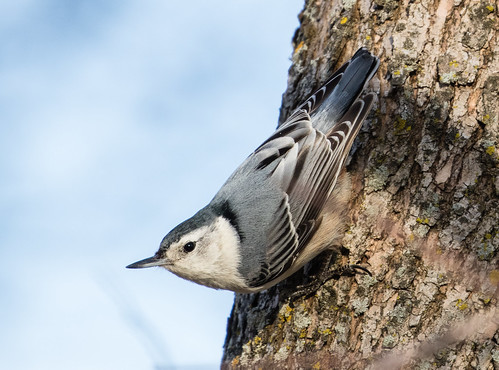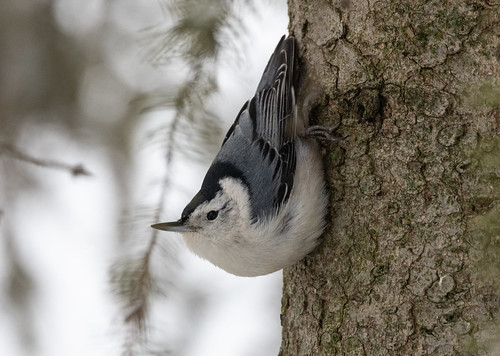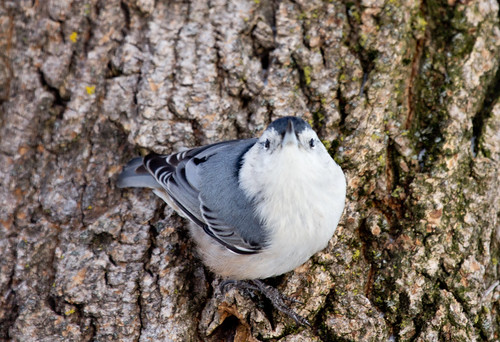Earlier this week I got an email from KAXE listeners Shenda and her daughter Ella K. They wrote:
We're grateful we have our nature to give us joy thru life’s uncertainties. Presently, we have had a large flock of Pine Grosbeaks, Blue Jays, Red-breasted Nuthatches, and a ton of our adorable chickadees. Unfortunately, we don’t see any more White-breasted Nuthatches? We surely had them this fall along with the Red-breasted. I don’t ever remember them migrating. But we don’t see any. Do they mate for life?
Our two nuthatches are ecologically quite different. Red-breasted Nuthatches are associated with firs and spruces. This is an irruptive species, moving south in large numbers in some winters but not others. But even in the northernmost parts of their range in much of Canada and southern Alaska, many individuals remain all winter as well. We northlanders get to see them year-round, but, except in the mountains and areas of the West where conifers predominate, Red-breasted Nuthatches are essentially a winter bird in much of the Lower-48, as far north as the southern half of Wisconsin and southern and western Minnesota. People planting conifer plantations have helped Red-breasted Nuthatches expand their range and numbers.
 |
| Red-breasted Nuthatch range map from Cornell Lab's All About Birds |
White-breasted Nuthatches are associated with deciduous forests, and are far less migratory, so most people who see them in winter can also find them in the same areas during the nesting season. Sometimes some do show up in winter at feeders, especially along the North Shore of Lake Superior, of areas where they don’t nest. These are probably young birds that haven’t found a suitable territory yet. White-breasted Nuthatch populations are more stable though slowly increasing. Climate change is almost certainly benefitting them at the northern extreme of their range, where maples and other hardwoods are slowly taking over as cold-adapted conifers die out.
 |
| White-breasted Nuthatch range map from Cornell Lab's All About Birds |
Except during the breeding season, Red-breasted Nuthatches are often found in flocks wandering about. In the forests where they nest, even at the height of breeding season I can often hear several different birds calling at the same time.
Not White-breasted Nuthatches! They are territorial year-round. They mate for life, with pairs sticking together through the winter. The only time we see more than just two White-breasteds is during the nesting season when fledglings are still associating with their parents, before they wander off to find their own territories. In winter, mated males get a big advantage by sticking with their mate—two sets of eyes and ears are more likely to detect predators and find good food sources than just one. But females get much less benefit from the arrangement because their mates follow them everywhere, pushing the females from the best feeding spots. When my female arrives at my feeder first, she must be quick to grab a chunk of peanut or other delectable item before the male flies in and chases her off.
How can I tell which is which? Both sexes have a wide black nape patch. The male’s crown is also black, so there is no contrast at all. The female’s crown is not quite black, so you can see the subtle difference where it meets the nape at close range.
 |
| The female's cap is a bit paler than her nape patch. |
 |
| The male's cap matches his nape. |
Because White-breasted Nuthatches are so territorial, it's a rare feeder in the north woods that would ever get more than one pair in winter. Like Red-breasted Nuthatches, they often associate with chickadee flocks, but White-breasteds are more standoffish, usually sticking to the periphery, away from the bustling activity. When they come to feeders, they very often grab something to eat elsewhere, as chickadees do. So they're not nearly as conspicuous as other feeder birds, and during mild spells, they can get the vast majority of their food elsewhere. That means they don't need to be in trouble for us to not detect them. When a pair disappears from an area where they’d been reliable, it’s likely that one member of the pair died and the other moved elsewhere to find a new mate. Because they are widely spread apart up here in the more coniferous north woods, it doesn’t mean anything in terms of their populations, but is still very sad.
Shenda and Ella K also noted that “There isn’t a lot of funding for our little birds anymore. Is there a site or organization in MN you find reputable that has valuable updated information?”
The best site for solid information about Minnesota bird numbers, though it's focused entirely on those birds that nest in the state rather than winter visitors, is the Minnesota Breeding Bird Atlas. It will eventually be out in book form, but the online version is GREAT. On each of my website species pages, there is a link to that species' entry on the Minnesota Breeding Bird Atlas website. Here, for example, is my White-breasted Nuthatch species page.




